- Home
- Mark R. Levin
Plunder and Deceit: Big Government's Exploitation of Young People and the Future Page 4
Plunder and Deceit: Big Government's Exploitation of Young People and the Future Read online
Page 4
Theoretically, Social Security is financed by payroll taxes on employees and employers and, to a lesser extent, taxes on Social Security benefits and income from trust fund assets. FICA taxes—payroll taxes under the Federal Insurance Contributions Act—are falsely said to fund Social Security and part of Medicare. Payroll taxes, as opposed to income taxes, apply to employees regardless of their income. They are most onerous on poorer workers and, of course, younger people who are just entering the workplace. They are also effectively a tax on employment as the employer must consider this fixed additional cost in his hiring decisions.
The rate of taxation to supposedly “fund” Social Security has been increasing over time. Currently workers pay 6.2 percent of their first $117,000 of earnings in Social Security taxes and their employers pay an additional 6.2 percent. The self-employed pay the full 12.4 percent themselves.6 When the program started in the 1930s, however, the tax rate was only 1 percent of income on a much lower income threshold and did not reach 3 percent until 1960.7 In fact, the amount of money subject to the Social Security payroll tax has grown significantly over time. From the 1930s until 1950, workers paid tax on the first $3,000 of their income. That cap did not reach $10,000 until the 1970s. Presently, workers pay FICA taxes on the first $117,000 of their income, and that amount will continue to rise with increases in the average wage.8
The age when retirement benefits are available has also increased. Initially, individuals had to live to age 65 to receive full benefits, with a reduced benefit for early retirement available at age 62. Today the full benefit age is 66 for individuals born in 1943–1954, and it is slated to go to 67 for individuals born in 1960 or later. Early retirement benefits will still be available at 62 years of age but at a reduced level. In 1984, recipients were required to pay income taxes on up to 50 percent of their benefits if their total income met a certain threshold of adjusted gross income. In 1993, even more of those benefits became subject to taxation and at a higher rate.9 In short, today’s workers are paying a higher tax rate on a larger portion of their income than many of the retirees whom they are helping to subsidize. They are also required to wait until they are older to receive benefits and will pay income taxes on a portion of those benefits.
But here is the worst news for younger workers and future generations. According to the Associated Press, a “historic shift” is occurring:
If you retired in 1960, you could expect to get back seven times more in benefits than you paid in Social Security taxes, and more if you were a low-income worker, as long as you made it to age 78 for men and 81 for women. As recently as 1985, workers at every income level could retire and expect to get more in benefits than they paid in Social Security taxes, though they didn’t do quite as well as their parents and grandparents. Not anymore.10
For the first time, people who are retiring today will receive less in benefits than they paid into the system in taxes. A lot of factors are involved in making these comparisons, of course, such as how long someone lives after retirement, how much they earned and thus paid into “the system,” when they decided to start receiving benefits, and so forth. (Incidentally, Social Security itself is very complicated. The Social Security Handbook “has 2,728 separate rules governing its benefits. And it has thousands upon thousands of explanations of those rules in its Program Operating Manual System.”)11 But in 2011, the Urban Institute found that a married couple who earned average lifetime salaries retiring that year had paid about $598,000 in Social Security taxes during their working years. However, they can only expect to receive about $556,000 in lifetime retirement benefits, assuming the husband lives to eighty-two and the wife lives to eighty-five.12
Nonetheless, Social Security is simultaneously growing and losing money. And these losses will become increasingly severe. In 2010, more money went to subsidize benefits than were received from taxes. According to the trustees of the Social Security “trust funds,” there will be a cash deficit averaging about $77 billion annually through 2018, which will then rise steeply as the number of beneficiaries continues to grow at a substantially faster rate than the number of covered workers.13 The ratio of beneficiaries to workers that I described earlier gets much worse. The combined DI and OASI “trust funds” will be completely depleted by 2033.14 In fact, the trustees forecast that expenditures will exceed tax revenues throughout the next seventy-five years.15 When they calculate the present value of the unfunded obligation for the next seventy-five years, it comes to $10.6 trillion, or $1 trillion more than last year’s prediction.16 Indeed, the $10.6 trillion will be necessary to fund obligations on top of the income the federal government receives from Social Security taxes.
The future suggests several unpleasant scenarios. Benefits will be slashed, benefits or other income will be heavily taxed, the retirement age will be pushed back further, and/or the federal government will eliminate other spending or go further into debt. Inasmuch as those retiring today will receive less than they “contributed” over the years into the system, it is difficult to see how younger people will be left with anything but horrendous debt and broken promises.
The late writer and economist Henry Hazlitt argued that this phenomenon is part of a broader problem. He explained that there are two factors that give rise to the majority of mistakes in economic policy: the “special pleading of selfish interests” and the tendency to ignore secondary consequences.17 The first factor is clear. Some economic policies benefit everyone or nearly everyone, while other policies only benefit a distinct group to the detriment of everyone else. For example, consider a proposal to subsidize corn producers. The group directly benefiting from the policy, in this case corn farmers, will vigorously lobby Congress for the subsidy. Members of Congress will get letters, visits, and contributions from farmers and their trade associations. However, they will hear almost nothing from the public at large on such a narrow issue. Therefore, the interests of the vocal minority will receive more weight than the interests of the majority. The measure passes as part of an omnibus spending bill and the cost of the new subsidy is added to the trillions of dollars spent every year by the federal government. The same has held true for Social Security over the years. Organized and vocal groups claiming to represent retirees and the soon to retire have successfully lobbied lawmakers to increase the number of individuals qualifying for Social Security and the amount and variety of benefits.
The second factor describes the tendency for public policy to be based on its immediate effects or its effect on a specific group without regard to long-term consequences for the economy and nation generally. For example, the benefits of a taxpayer bailout to a failing carmaker are immediate and evident for the carmaker, its investors, and its employees. But the financial dislocation and lost fiscal opportunities resulting from the diversion of economic resources to tax subsidies are distant and disregarded. If the carmaker files for bankruptcy, the company is able and required to streamline its operations, including reducing its workforce and employee benefits and offloading certain debt. Although this allows the newly organized company a fresh opportunity to regain profitability and survive in the longer term, including expanding and hiring down the road, the immediate upshot of the reorganization, with its downsizing, and so on, is visible and tangible. Hazlitt explained the phenomenon this way:
In this lies almost the whole difference between good economics and bad. The bad economist sees only what immediately strikes the eye; the good economist also looks beyond. The bad economist sees only the direct consequences of a proposed course; the good economist looks also at the longer and indirect consequences. The bad economist sees only what the effect of a given policy has been or will be on one particular group; the good economist inquires also what the effect of the policy will be on all groups.18
Clearly the ruling generation and generations unborn are harmed most by these practices, particularly with massive generational transfer payments and debt accumulation. Younger people do not have powerful organizations lob
bying the federal government on their behalf against current and future profligate spending and borrowing. Conversely, the American Association of Retired People (AARP) is an extremely powerful and influential presence on Capitol Hill, relentlessly pressuring Congress for expanded government subsidies for the rising generation and against most serious efforts to reform Social Security and Medicare.
At the heart of the problem is the ruse that Social Security is an insurance program, making an honest national discussion about it extremely difficult. In truth, in no legal, ethical, or rational sense are there actually trust funds or individual trust accounts. Most workers pay into the system each month or bimonthly. In turn, those tax proceeds are used to pay current Social Security beneficiaries. Therefore, it differs fundamentally from an individual, directly funded insurance policy or pension fund account like a 401(k), where a person contributes to a specific account over time and that money is invested just for the beneficiary’s future. In fact, Social Security is not even a true pay-as-you-go system. In the past, when more money was received by the federal government than was necessary to cover current beneficiaries, the excess funds were not returned to the taxpayers. Instead, the taxes were used to fund other general expenditures of the federal government. Of course, this is a shell game. If any private investment firm or insurance company conducted itself this way, it would risk prosecution for conducting an unlawful Ponzi scheme. And today, younger workers are compelled to “contribute” payroll taxes into a system that benefits current retirees and will not exist, at least not as promised, when they reach retirement age.
Consequently, there are no real assets in the Social Security “trust funds.” The federal government uses an accounting measure reflecting how one part of the government owes money to another. At best it can be said that Social Security “trust funds” consist of specially issued government bonds that earn interest. Even so, the interest is owed by the federal government, requiring it to issue additional IOUs to the Treasury Department. Presumably, when the federal government runs out of funds to pay Social Security benefits, it will have to cash in those bonds. But from where does the money to pay off the bonds come? The general revenue of the federal government—that is, the taxpayers and the accumulation of more debt. The late Nobel Laureate for Economics, Dr. Milton Friedman, explained that these “trust funds” are nothing but an accounting measure to mislead the public and “preserve the fiction that Social Security is insurance.”19
Dr. Friedman described how Social Security uses terms like “contributions” and “benefits” instead of “taxes” and “subsidies.” The statists use these terms and others, such as “Old Age and Survivors Insurance,” intentionally. In point of fact, after Social Security was enacted as part of President Franklin Roosevelt’s New Deal, he acknowledged to an aide that the payroll taxes used to “fund” the system were regressive, but their purpose was actually political. Roosevelt declared: “I guess you’re right on the economics. They are politics all the way through. We put those payroll contributions there so as to give the contributors a legal, moral, and political right to collect their pensions and their unemployment benefits. With those taxes in there, no damn politician can ever scrap my social security program.”20 As I pointed out in Liberty and Tyranny, “The taxes may never have been a problem of economics to Roosevelt, but the economic problem he unleashed on American society has become immense, thanks to the politics he played with the people and their future.”21
It is both unnerving and unsurprising how little knowledge the New Deal masterminds possessed when remaking the federal government. Remarkably, the age originally established for the receipt of full Social Security benefits was not based on a thorough analysis, despite that single decision’s effect on the economy, the size of the workforce, tax revenues, savings rates, and so on. Instead, it was literally plucked from thin air.
Why was age 65 chosen . . . ? According to Robert Myers, who worked on the creation of the Social Security program beginning in 1934 and later served in various senior and appointed capacities at the Social Security Administration, “why not?” Myers wrote, “Age 65 was picked because 60 was too young and 70 was too old. So we split the difference.”22
Moreover, when Roosevelt signed the Social Security Act in 1935, he boldly proclaimed his utopian ambition thusly:
This law . . . represents a cornerstone in a structure which is being built but is by no means complete. It is a structure intended to lessen the force of possible future depressions. It will act as a protection to future Administrations against the necessity of going deeply into debt to furnish relief to the needy. The law will flatten out the peaks and valleys of deflation and of inflation. It is, in short, a law that will take care of human needs and at the same time provide for the United States an economic structure of vastly greater soundness.23 (Italics added)
Of course, many have benefited from Social Security over the decades, especially the elderly. But the overall structure, which as Roosevelt insisted at the outset, put politics before economics, was and is, in the end, economically and fiscally irrational and irresponsible. Recently, another warning was issued by the Congressional Budget Office (CBO) in its 2014 annual budget outlook, in which it announced that Social Security (and other entitlement programs) is “unsustainable” and will drive federally held debt to historic levels, thereby threatening the overall economy.24
Top elected officeholders in the nation have been repeatedly and specifically warned about the coming upheaval. As compelled by law, on July 28, 2014, Social Security’s trustees issued their annual letters to both House Speaker John Boehner and Senate President (Vice President) Joe Biden on the financial state of, among other things, the Social Security system. They wrote, in part: “Estimates in the 2014 Trustees Report show that although the Old-Age and Survivors Insurance (OASI) Trust Fund and the theoretical combined OASI and Disability Insurance (DI) Trust Funds are adequately financed . . . through the next 10 years under intermediate assumptions, the DI fund alone is not. Under the intermediate assumptions of the 2014 Trustees Report (those representing the Trustees’ best estimate of future economic and demographic trends), the DI Trust Fund reserves steadily decline, falling below 20 percent of annual cost by the beginning of calendar year 2016 and becoming depleted in the fourth calendar quarter of 2016.”25 (Italics added) If anything, the trustees understate the overall and looming Social Security disaster.
Predictably, the statists cling zealously to their utopianism and dogmatically reject virtually every suggestion to restructure Social Security. On October 15, 2010, 101 Democratic members of Congress wrote President Obama, insisting that any proposals by the National Commission on Fiscal Responsibility and Reform to modify Social Security benefits, adjust age requirements, or introduce private investment options would be blocked in Congress. They declared, in part: “We write today to express our strong support for Social Security and our view that it should be strengthened. We oppose any cuts to Social Security benefits, including raising the retirement age. We also oppose any effort to privatize Social Security, in whole or in part. . . . If any of the Commission’s recommendations cut or diminish Social Security in any way, we will stand firmly against them.”26
Rather than exploring even modest but still meaningful options and alternatives to the current “unsustainable” Social Security system—such as ensuring that workers age fifty-five and over remain covered under the traditional Social Security system with no change in promised benefits, while allowing younger workers to opt out of Social Security and invest in private sector retirement alternatives—statists demand greater federal centralization and control, this time over the individual’s private retirement plans, as an increasingly desperate federal government looks for ways to expand its reach and confiscate more earnings from the rising generation.
For example, 401(k) plans have enabled approximately 52 million American workers to own stocks and bonds as part of their private retirement portfolios. But there is a gro
wing movement to eliminate these tax and savings benefits in order to further fund federal “insurance.” As explained by the Cato Institute’s Michael D. Tanner: “Teresa Ghilarducci, director of the Schwartz Center for Economic Policy Analysis at the New School in New York, has argued before Congress that 401(k) plans should be abolished, and replaced by an expanded social-insurance system. Representative Jim McDermott (D., Wash.), who sits on the tax-writing Ways and Means Committee, has pronounced himself ‘intrigued’ by Ghilarducci’s ideas. And [former] Congressman George Miller (D., Calif.) has called for eliminating or reducing the tax break for 401(k) contributions. The Obama administration has also sought to limit tax breaks for 401(k)s, although primarily for wealthier participants. In a speech calling for the expansion of Social Security, Senator Elizabeth Warren (D., Mass.) criticized private retirement accounts like 401(k) plans ‘that leave the retiree at the mercy of a market that rises and falls, and, sometimes, at the mercy of dangerous investment products.’ ” Tanner points out that “No policy proposed in recent years would have done more to expand capital ownership than allowing younger workers to invest a portion of their Social Security taxes through personal accounts. One of the unsung benefits of such Social Security reform is that it would enable even the lowest-paid American worker to benefit from capital investment. Indeed, since the wealthy presumably already invest as much as they wish to, lower-income workers would be the primary beneficiaries of this new investment opportunity.”27
The American people are facing some very unpleasant realities about the nation’s financial vulnerabilities. The federal government is deeply in debt; the largest federal program, Social Security, is hemorrhaging money; the national birthrate does not provide enough working people from whom money can be transferred to subsidize beneficiaries; and most individuals do not have enough personal savings to get them through severe economic times. As the late economist Dr. Herbert Stein once wrote, “If something can’t go on forever, it will stop.”28 And in this case, the federal government’s biggest program will stop with a crash, taking down the older recipients and the younger payers alike.

 The Liberty Amendments: Restoring the American Republic
The Liberty Amendments: Restoring the American Republic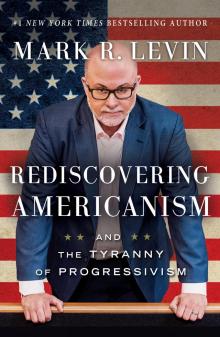 Rediscovering Americanism: And the Tyranny of Progressivism
Rediscovering Americanism: And the Tyranny of Progressivism Plunder and Deceit: Big Government's Exploitation of Young People and the Future
Plunder and Deceit: Big Government's Exploitation of Young People and the Future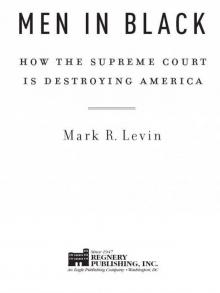 Men in Black: How Judges Are Destroying America
Men in Black: How Judges Are Destroying America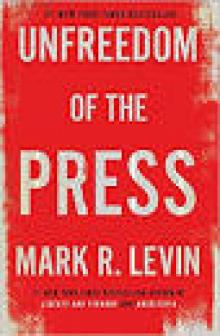 Unfreedom of the Press
Unfreedom of the Press Ameritopia: The Unmaking of America
Ameritopia: The Unmaking of America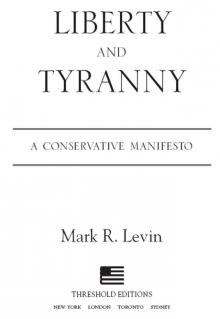 Liberty and Tyranny
Liberty and Tyranny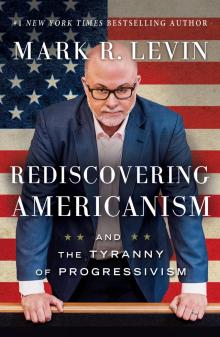 Rediscovering Americanism
Rediscovering Americanism Ameritopia
Ameritopia Plunder and Deceit
Plunder and Deceit